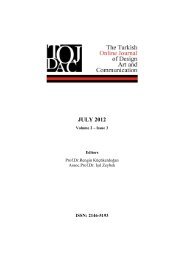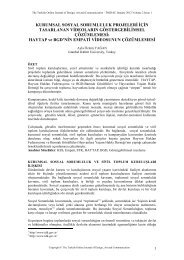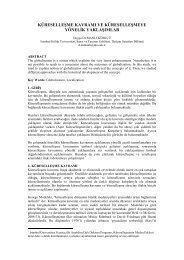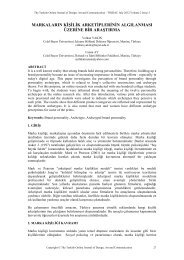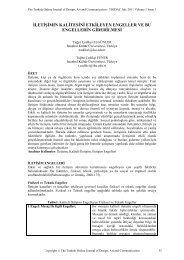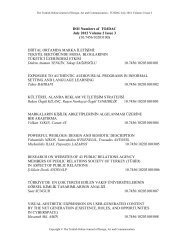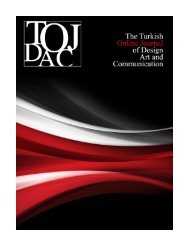aprıl 2012 - tojdac.org
aprıl 2012 - tojdac.org
aprıl 2012 - tojdac.org
You also want an ePaper? Increase the reach of your titles
YUMPU automatically turns print PDFs into web optimized ePapers that Google loves.
The Turkish Online Journal of Design, Art and Communication - TOJDAC April <strong>2012</strong> Volume 2 Issue 2<br />
VISUAL CULTURE: ANTENNA AND ROOTS<br />
Maria Celeste de Almeida WANNER<br />
Federal University of Bahia, School of Fine Arts, Brazil<br />
mcawanner@hotmail.com<br />
Valter Luis Dantas ORNELLAS<br />
Federal University of Bahia, School of Fine Arts, Brazil<br />
ornellas.valter@gmail.com<br />
ABSTRACT<br />
The gap between the digital era in undeveloped places, in the 21st century, is an important<br />
issue to be discussed. Based in the research called Antenna and Roots, developed at the Fine<br />
Art School at the Federal University of Bahia, Brazil, called Antenna and Roots, this paper<br />
proposes a dialogue between Visual Culture and contemporary visual languages, creative<br />
process, its methodology, and how the students are encourage to investigate with low tech<br />
equipments, certain that what makes a good art work is not only the equipment, but how an<br />
artist approaches material, equipments, etc., in order to materialize ideas, along the<br />
knowledge and understand about the world they live, without illustrating theories.<br />
Keywords: Visual culture, Visual arts, Digital image, Antenna and Roots.<br />
1. INTRODUCTION<br />
The gap between the so called low and high technology can be seen in most of undeveloped<br />
countries in contrast with developed ones, where the increase of new equipments is extremely<br />
fast. This fact has two mainly aspect. One is the impact of the new technologies in many<br />
cultures with an invasion of all kind of machines, such as cellular phone, i-pads, compact and<br />
portable computer, wireless internet, etc. The second aspect is how those cultures may deal<br />
with this fast transformation in communication, in order to preserve its own traditional roots.<br />
With the advance of digital technology, we are officially incorporating machine words as a<br />
universal language, and what we call now Visual Culture has many definitions and theories<br />
approaches in different areas of knowledge, as Science, Arts, Religion, Philosophy, etc.<br />
When Socrates was opposed to the written word because it may erode memory, he believed<br />
that the switch from oral to written knowledge transmission would end up making people<br />
reliant on written documents as memory, and truth could be hard to distinguish. Now we are<br />
facing a challenge between written words, oral knowledge and machines memory. What<br />
Socrates actually voiced was the mistrust of new technology — or ideas, for that matter — a<br />
mistrust that has reemerged in the last 30 or 40 years as visual culture encroached on written<br />
culture.<br />
While many scholars are studding the impact of digitalization on written language, others are<br />
turning towards visual languages, asking what we can do with the machine in order to be<br />
creative. It is well known that all machines are only instruments, and when the discussion is<br />
about visual arts, this issue has to be more considered, as the rise of new visual language, such<br />
as video and computer art, mediums that apply digital technology, since 1970. By that time,<br />
with a change in all areas of human knowledge, John Berger (1972) understood Visual<br />
Culture as mainly acknowledges the reality of living in a world of cross-mediation—where<br />
our experience of culturally meaningful visual content appears in multiple forms, and visual<br />
content and codes migrate from one form to another, i.e., the experience of everyday life can<br />
be described as code-switching or hacking the visual codes around us to navigate and<br />
negotiate meaning. Therefore, since the post-modern period, contemporary studies on Visual<br />
Culture has being focus in deconstruct potential visual/textual binary opposition, as most of<br />
Copyright © The Turkish Online Journal of Design, Art and Communication 108



